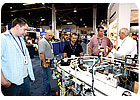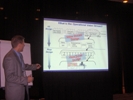
TheAssembly Technology Expocelebrated its 30th anniversary in late September. But, that milestone was marked without much fanfare. It was overshadowed by the slowly rebounding economy.
The annual trade show created by ASSEMBLY magazine in 1979 is now one of several exhibits co-located in Rosemont, IL. All six shows are touted as “the Midwest’s total resource event for advanced design and manufacturing.”
Reactions on the show floor were mixed this year. Many exhibitors and attendees said business is “slow but steady.” They’re cautiously optimistic that the worst recession since the Great Depression is over.
The U.S. economy experienced moderate improvement in September, paced by bullish activity on the New York Stock Exchange. For instance, the Institute for Supply Management claims that the manufacturing sector grew for the second straight month. Both new orders and production showed positive signs of activity.
In addition, General Motors Co. announced plans to boost production in 2010. In fact, the same day thatATExpoopened, GM proclaimed that it was adding a third shift at three of its assembly plants.
But, activity on the show floor did not directly reflect that good news. There were fewer attendees from Detroit than in previous years, because automakers and suppliers have sharply curtailed their travel budgets. According to one long-time exhibitor, participation from the automotive sector at this year’s show was down by more than 25 percent.

Who's Who See What's What
Despite the economy, the 2009Assembly Technology Expostill attracted a who’s who of manufacturing. Companies that had a presence on the show floor ranged from Boston Scientific to Northrop Grumman and Caterpillar to Whirlpool. Visitors came from as far away as New Zealand looking for solutions to their assembly challenges.“Attendance was down, but [we received] quality leads from a broad cross section of the manufacturing community, including medical, automotive, consumer products and communications,” notes Uwe Peregi, executive vice president and general manager of Herrmann Ultrasonics Inc. The company featured its new HiQ evolution welder at its booth.
“Overall, [our] numbers were within 4 percent of last year,” claims Larry Stockline, president of Promess Inc. “We use a ‘hot, warm, cold’ formula to qualify our leads, and there was a major shift in this measurement against last year’s numbers.
“‘Hots’ were down 20 percent, which is a strong indication of negative short-term capital equipment demand,” adds Stockline. “‘Warms’ were up 27 percent, which bodes well for the future. ‘Colds’ were down 31 percent, so there were fewer tourists and literature collectors.”
David Titone, director of sales for North America at EFD Inc., says there were fewer tire-kickers at the event than in previous years. “Many people who stopped by our exhibit had an agenda,” he explains. “They came to discuss existing projects. Some even brought actual parts that they were working on.”
Rick Blake, president of Edgewater Automation LLC, agrees that quality outweighed quantity at this year’s ATExpo. “People are less likely to travel [today] due to cost restraints and resource constraints,” explains Blake. “When an engineer leaves the plant now, there is no one to cover for them. So, when we did have a customer visit our booth, they had a reason to be there. In addition, it seemed as though people had done some research before coming and made it a point to visit our booth.”
Like last year, many exhibitors focused heavily on medical device assembly, because one of the shows co-located withATExpoisMD&M Midwest, which is geared to medical design and manufacturing. The medical device industry continues to witness solid growth, fueled by the aging baby boomer population.
And, theGreen Manufacturing Expoensured widespread interest in the fast-growing renewable energy market. An educational session devoted to wind power attracted a packed audience.
According to oneATExpoexhibitor, 26 percent of his booth traffic was comprised of individuals involved in battery, solar and wind power projects. In addition to machine builders and OEMs, there was strong activity from subsuppliers, such as companies that build electrical and electronic components used in solar panels.
Several stalwarts from previous shows, such as the wire processing line and theEASi Line, were missing from the 2009Assembly Technology Expo. They were replaced with free educational sessions that were conveniently located on the show floor, such as theInnovation Briefs Theatreand theLean Factory.
Exhibitors used the 60-seat Innovation Briefs Theatre to present 30-minute briefings on new technology. For instance, Henkel Corp. briefed attendees on two-part silicones, while EFD used the new format to discuss fluid viscosity.
“This proved to be a nice forum, especially for introducing new products,” says Titone. As part of its briefing, EFD discussed its new Ultimus V high-precision dispenser, which was unveiled at ATExpo. “We were able to capture an interested audience, including several people who had not visited our booth prior to the session,” Titone points out.

Lean Lessons
ASSEMBLY sponsored several educational sessions at the 2009 Assembly Technology Expo, with lean-related topics attracting the most interest. Many companies are eager to apply state-of-the-art lean techniques as business conditions start to pick up.
According to Kevin Duggan, president of Duggan Associates, manufacturers that want to go beyond lean need to focus on “operational excellence.” Duggan says that requires “making a jump from just being a mature lean company. It’s not just about flow.”
Duggan claims there are eight principles of operational excellence:
- Create lean value streams.
- Make lean value streams flow.
- Make lean value streams flow visually.
- Create standard work for lean value stream flow.
- Make abnormal value streams flow visually.
- Create standard work for abnormal value stream flow.
- Teach employees to maintain and improve flow to the customer.
- Free management to work on offense (i.e., growing the business).
To achieve operational excellence, manufacturers need to create a roadmap. “You must set a destination and know exactly where you’re going in a way that everyone in your company can understand,” Duggan points out.
During a workshop session, Matt Zayko, an associate at the Lean Transformations Group, explained how lean philosophy has evolved since 1996, when Lean Thinking was first published. The landmark book by James Womack and Daniel Jones explained how a wide variety of companies in different industries have used lean principles to transform their organizations.
Lean thinking principles circa 1996 focused on the following five processes:
- Specify value from the customer’s perspective.
- Identify the value stream.
- Flow the value.
- Pull.
- Perfection.
According to Zayko, today’s lean hypothesis is different. It focuses on:
- Specify the value.
- Value stream design.
- Flow design.
- Connectivity.
- Reflect and improve.
Zayko also believes too many manufacturers address takt time the wrong way. “Frequently, takt time has been largely used to design overall process flows with new programs,” he explains. “This results is overly complex and wasteful production systems. Takt is only a reference and forecast that’s never guaranteed-just like the weather.” A
